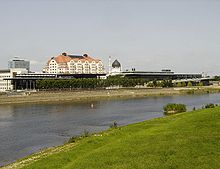New terrace

The Neue Terrasse is an ensemble of buildings in Dresden . In particular, it leans against the Brühlsche Terrasse and continues it in a westerly direction. Just like the Brühlsche Terrasse, the Neue Terrasse is a pedestrian street on the banks of the Elbe .
location
The Neue Terrasse is located in the Wilsdruffer suburb on the left side of the Elbe. On the banks of the Neue Terrasse, the Elbe flows in a north-westerly direction, so that the Neue Terrasse is limited to the south by Bernhard-von-Lindenau- Platz and the end of the Terrassenufers and to the south-west by Devrientstrasse and the Ostra-Ufer (road). In the northwest, the Marienbrücke closes the terrace.
Historically, the site is located on an old fortress of the city fortress , which has long been known as the "Small Ostragehege ". At the beginning of the 20th century the area was used industrially and had a rail connection. The entire area is directly connected to historical buildings such as the Zwinger and the Semperoper .
Development
The buildings on the Neue Terrasse are among the most outstanding modern buildings in Dresden. They were built between 1913 and 2004 and, due to their height, are in direct line of sight to historical buildings in the old town.
Buildings
Starting to the east is the plenary hall and glass wing of the Saxon State Parliament on the Elbe. The main entrance to the building is on Bernhard-von-Lindenau-Platz. The wings in which the parliamentarians' offices are located were built in the Bauhaus style between 1928 and 1931 . The new parts, which were created between 1991 and 1994, are mainly dominated by glass.
The Erlweinspeicher is attached to the state parliament . Built as a warehouse between 1913 and 1914, it is not only a relic of the industrial era with a direct view of the Zwinger and Brühl's terrace, but also the oldest building in the ensemble. Hans Erlwein succeeded in inconspicuously embedding the very high reinforced concrete structure in the Dresden city center by structuring the roof. After it remained unused for a long time, the Erlweinspeicher was completely renewed from 2004 to 2006 and the interior was rebuilt so that it is now operated as a hotel by the Maritim Hotelgesellschaft .
The newest building is the International Congress Center , which forms a complex with the hotel in Erlweinspeicher and is also operated by Maritim. It has a rising roof terrace, which is supposed to be the end of all Dresden terraces . This building, whose curved facade takes up the river arches of the Elbe, is characterized by a high proportion of glass. It is regarded as a model for the integration of modern or postmodern buildings in city silhouettes and views, especially if they are protected by the Dresden Elbe Valley, as in Dresden .
References to the Brühl Terrace
Some parts of the New Terrace refer to the Brühlsche Terrasse . This is located on the northern structures of the old city fortress of Dresden and thus elevated above the Terrassenufer, an important thoroughfare. A recognizable element of the Brühlsche Terrasse is the entrance to the congress center in the form of a wide flight of stairs. This open staircase leads to a wide, freely accessible roof terrace that rises to the north. Another motif of the Brühl Terrace are the trees arranged in groups in front of the Landtag, as they were laid out on the Brühl Terrace at the level of the Ständehaus .
Flood
The new terrace is located on a fortress of the old city fortress . Dresden's oldest parts are elevated on both the old town and the Neustadt side of the Elbe. These parts are also protected from strong floods from the Elbe . The new terrace is lower and is flooded when the Elbe floods. The Bernhard-von-Lindenau-Platz was reached in 2002 by the Weißeritz , which that year flowed into the Elbe at the north-western end of the Neue Terrasse. A little further down the Elbe, before it was diverted, there was the mouth of the Erzgebirge River.
The congress center in particular is protected from floods by a sheet pile wall as a single object. At around 7.50 m (i.e. around 3.75 times normal) the 2 m high wall is not yet reached (see photo). The buildings closer to the historic city center are always elevated.
Web links
Coordinates: 51 ° 3 '27.1 " N , 13 ° 43' 59.3" E


